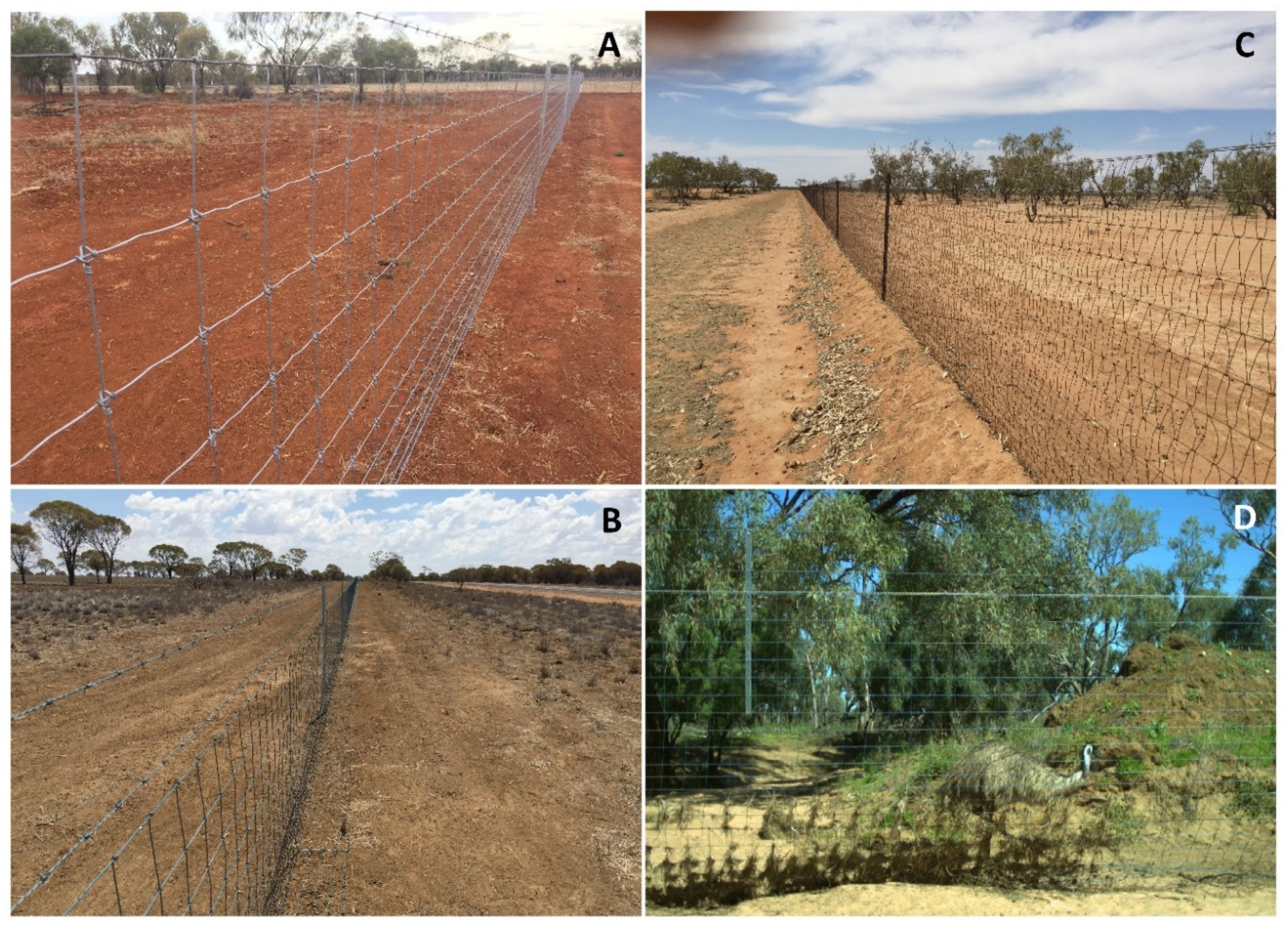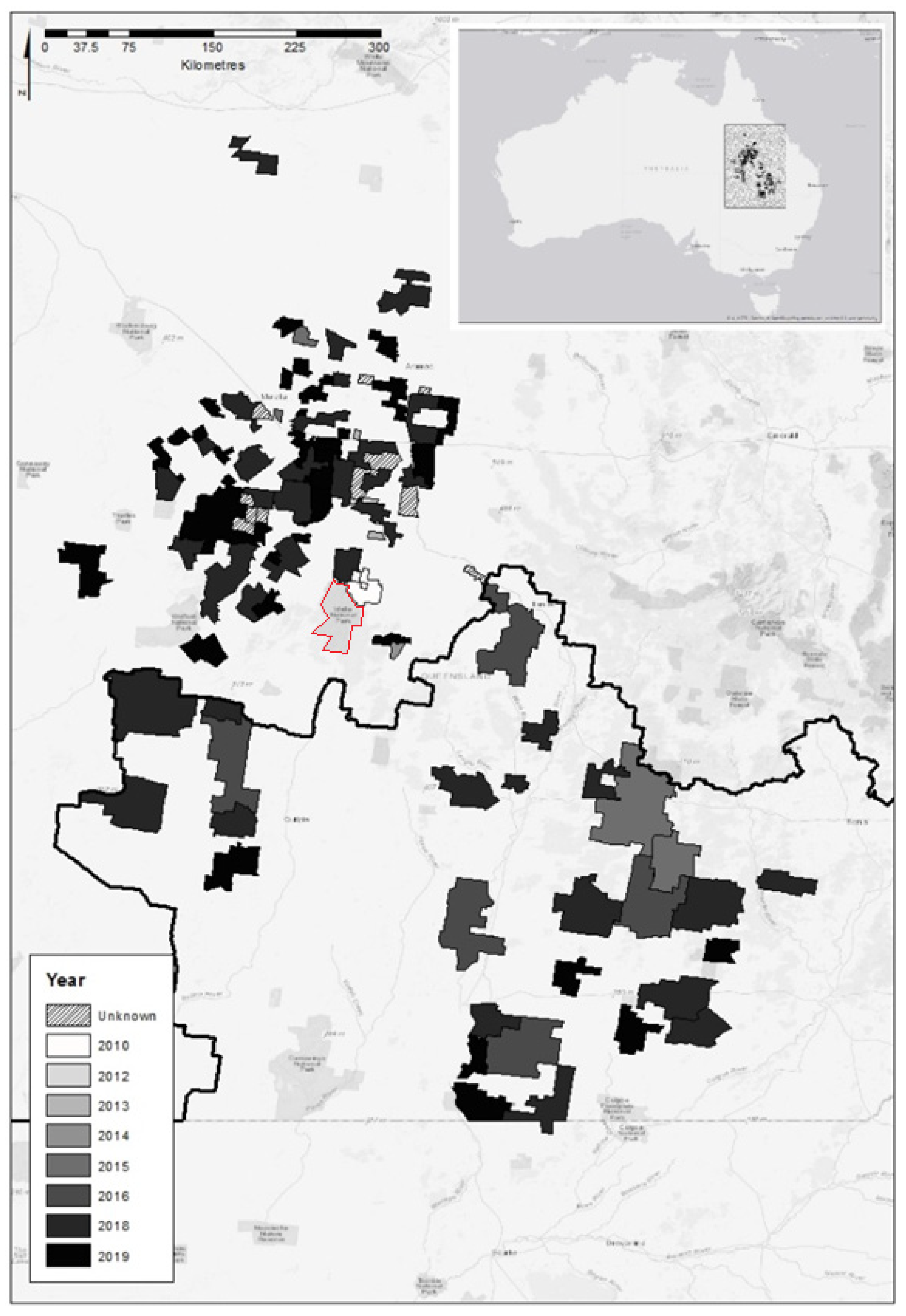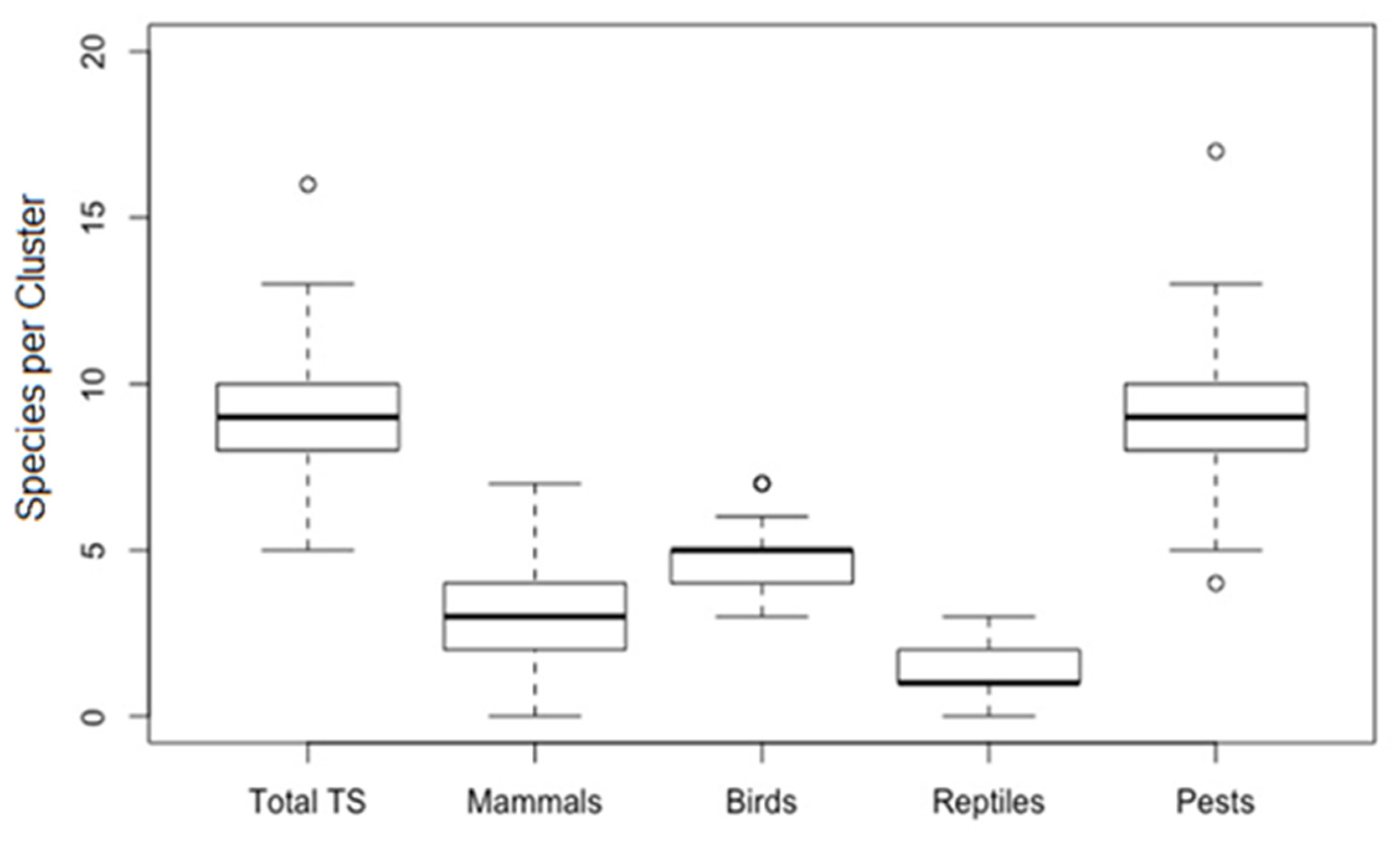Expansion of Vertebrate Pest Exclusion Fencing and Its Potential Benefits for Threatened Fauna Recovery in Australia
Simple Summary
Abstract
1. Introduction
2. Materials and Methods
3. Results
4. Discussion
5. Conclusions
- Creation of new locations where it is possible to change the trajectory of extant threatened species populations;
- Creation of new locations where it is possible to reintroduce locally extinct species;
- Creation of new locations suitable for improving antipredator defences and overcoming prey naivety issues;
- Addition of new biomes not currently represented in the national fenced reserve system;
- Opportunities to develop private–public partnerships to share the costs of constructing high-security conservation fences (i.e., new, large conservation fences can be erected for a fraction of current costs);
- Reduction or shifting of ongoing fence maintenance costs to sources non-reliant on government, philanthropy or public donations;
- Alleviation of threatened species’ overpopulation in some of the current conservation reserves.
Supplementary Materials
Author Contributions
Funding
Acknowledgments
Conflicts of Interest
References
- Woinarski, J.; Burbidge, A.; Harrison, P. Ongoing unraveling of a continental fauna: Decline and extinction of Australian mammals since European settlement. Proc. Natl. Acad. Sci. USA 2015, 112, 4531–4540. [Google Scholar]
- Woinarski, J.; Burbidge, A.; Harrison, P. The Action Plan for Australian Mammals 2012; CSIRO Publishing: Clayton, Australia, 2014. [Google Scholar]
- McKenzie, N.; Burbidge, A.; Baynes, A.; Brereton, R.; Dickman, C.; Gordon, G.; Gibson, L.; Menkhorst, P.; Robinson, A.; Williams, M. Analysis of factors implicated in the recent decline of Australia’s mammal fauna. J. Biogeogr. 2007, 34, 597–611. [Google Scholar]
- Allen, B. A comment on the distribution of historical and contemporary livestock grazing across Australia: Implications for using dingoes for biodiversity conservation. Ecol. Manag. Restor. 2011, 12, 26–30. [Google Scholar]
- Ringma, J.; Legge, S.; Woinarski, J.; Radford, J.; Wintle, B.; Bode, M. Australia’s mammal fauna requires a strategic and enhanced network of predator-free havens. Nat. Ecol. Evol. 2018, 2, 410–411. [Google Scholar] [CrossRef]
- Hayward, M.; Kerley, G. Fencing for conservation: Restriction of evolutionary potential or a riposte to threatening processes? Biol. Conserv. 2009, 142, 1–13. [Google Scholar]
- Druce, H.; Pretorius, K.; Slotow, R. The response of an elephant population to conservation area expansion: Phinda Private Game Reserve, South Africa. Biol. Conserv. 2008, 141, 3127–3138. [Google Scholar]
- Moseby, K.; O’Donnell, E. Reintroduction of the greater bilby, Macrotis lagotis (Reid) (Marsupialia: Thylacomyidae), to northern South Australia: Survival, ecology and notes on reintroduction protocols. Wildl. Res. 2003, 30, 15–27. [Google Scholar] [CrossRef]
- McKnight, T. Barrier fencing for vermin control in Australia. Geogr. Rev. 1969, 59, 330–347. [Google Scholar]
- Smith, D.; King, R.; Allen, B. Impacts of exclusion fencing on target and non-target fauna: A global review. Biol. Rev. 2020. [Google Scholar] [CrossRef]
- Allen, B.; West, P. Influence of dingoes on sheep distribution in Australia. Aust. Vet. J. 2013, 91, 261–267. [Google Scholar]
- Cockfield, G.; Botterill, L.; Kelly, S. A prospective evaluation of contingent loans as a means of financing wild dog exclusion fences. Rangel. J. 2018, 40, 591–601. [Google Scholar]
- Darkoh, M.; Mbaiwa, J. Globalisation and the livestock industry in Botswana. Singap. J. Trop. Geogr. 2002, 23, 149–166. [Google Scholar] [CrossRef]
- Otto, T. Developing and Implementing Effective Black Bear Exclusion Fences to Protect Mobile Apiaries. Master’s Thesis, Michigan State University, East Lansing, MI, USA, 2013. [Google Scholar]
- Dickman, C. Fences or ferals? Benefits and costs of conservation fencing in Australia. In Fencing for Conservation; Somers, M., Hayward, M., Eds.; Springer: Berlin, Germany, 2012; pp. 43–63. [Google Scholar]
- Ringma, J.; Legge, S.; Woinarski, J.; Radford, J.; Wintle, B.; Bentley, J.; Burbidge, A.; Copley, P.; Dexter, N.; Dickman, C.; et al. Systematic planning can rapidly close the protection gap in Australian mammal havens. Conserv. Lett. 2019, 12, e12611. [Google Scholar]
- Legge, S.; Woinarski, J.; Burbidge, A.; Palmer, R.; Ringma, J.; Radford, J.; Mitchell, N.; Bode, M.; Wintle, B.; Baseler, M. Havens for threatened Australian mammals: The contributions of fenced areas and offshore islands to the protection of mammal species susceptible to introduced predators. Wildl. Res. 2018, 45, 627–644. [Google Scholar]
- Abbott, I. Origin and spread of the cat, Felis catus, on mainland Australia, with a discussion of the magnitude of its early impact on native fauna. Wildl. Res. 2002, 29, 51–74. [Google Scholar]
- Rolls, E. They All Ran Wild: The Animals and Plants that Plague Australia; Angus & Robertson Publishers: Sydney, Australia, 1969. [Google Scholar]
- Doherty, T.; Davis, R.; van Etten, E.; Algar, D.; Collier, N.; Dickman, C.; Edwards, G.; Masters, P.; Palmer, R.; Robinson, S. A continental-scale analysis of feral cat diet in Australia. J. Biogeogr. 2015, 42, 964–975. [Google Scholar]
- Doherty, T.; Dickman, C.; Johnson, C.; Legge, S.; Ritchie, E.; Woinarski, J. Impacts and management of feral cats Felis catus in Australia. Mammal Rev. 2017, 47, 83–97. [Google Scholar]
- Burbidge, A.; McKenzie, N. Patterns in the modern decline of Western Australia’s vertebrate fauna: Causes and conservation implications. Biol. Conserv. 1989, 50, 143–198. [Google Scholar]
- Department of the Environment. SPRAT Database - List of Threatening Processes. Available online: http://www.environment.gov.au/cgi-bin/sprat/public/publicgetkeythreats.pl (accessed on 27 February 2019).
- Allen, B.; Fleming, P. Reintroducing the dingo: The risk of dingo predation to threatened vertebrates of western New South Wales. Wildl. Res. 2012, 39, 35–50. [Google Scholar]
- Allen, B.; Leung, L. Assessing predation risk to threatened fauna from their prevalence in predator scats: Dingoes and rodents in arid Australia. PLoS ONE 2012, 7, e36426. [Google Scholar]
- Major, R. Predation and Hybridisation by Feral Dogs (Canis Lupus Familiaris)—Key Threatening Process Listing; New South Wales Department of Environment, Climate Change, and Water: Sydney, Australia, 2009.
- Pedler, R.; Brandle, R.; Read, J.; Southgate, R.; Bird, P.; Moseby, K. Rabbit biocontrol and landscape-scale recovery of threatened desert mammals. Conserv. Biol. 2016, 30, 774–782. [Google Scholar]
- Australian Wildlife Conservancy. Feral Herbivore Control. Available online: https://www.australianwildlife.org/our-work/feral-herbivore-control/ (accessed on 9 September 2019).
- Australian Wildlife Conservancy. Feral Cat and Fox Control. Available online: https://www.australianwildlife.org/our-work/feral-cat-and-fox-control/ (accessed on 9 September 2019).
- Legge, S.; Murphy, B.; McGregor, H.; Woinarski, J.; Augusteyn, J.; Ballard, G.; Baseler, M.; Buckmaster, T.; Dickman, C.; Doherty, T.; et al. Enumerating a continental-scale threat: How many feral cats are in Australia? Biol. Conserv. 2017, 206, 293–303. [Google Scholar]
- Moseby, K.; Lollback, G.; Lynch, C. Too much of a good-thing, successful reintroduction leads to overpopulation in a threatened mammal. Biol. Conserv. 2018, 219, 78–88. [Google Scholar] [CrossRef]
- Short, J. The Characteristics and Success of Vertebrate Translocations within Australia; Australian Government Department of Agriculture, Fisheries and Forestry: Canberra, Australia, 2009.
- Department of Primary Industries and Fisheries. History of Barrier Fences in Queensland; Land Protection (Invasive Plants and Animals): Brisbane, Australia, 2007.
- RAPAD; QFPI. RAPAD Cluster Fencing Project Round 1: March—2016 April 2018 Final report: Section 1; Queensland Government: Queensland, Australia, 2018.
- Allen, B.; West, P. Re: Dingoes are a major causal factor for the decline and distribution of sheep in Australia. Aust. Vet. J. 2015, 93, 90. [Google Scholar]
- Pahl, L. Macropods, feral goats, sheep and cattle. 1. Equivalency in how much they eat. Rangel. J. 2019, 41, 497–518. [Google Scholar] [CrossRef]
- Waters, C.; McDonald, S.; Reseigh, J.; Grant, R.; Burnside, D. Insights on the relationship between total grazing pressure management and sustainable land management: Key indicators to verify impacts. Rangel. J. 2019, 41, 535–556. [Google Scholar] [CrossRef]
- Hacker, R.; Sinclair, K.; Pahl, L. Prospects for ecologically and socially sustainable management of total grazing pressure in the southern rangelands of Australia. Rangel. J. 2019, 41, 581–586. [Google Scholar] [CrossRef]
- Allen, B. FOFI5M: Taking threatened species recovery to the next level. In Proceedings of the Restore, Regenerate, Revegetate: A Conference on Restoring Ecological Processes, Ecosystems and Landscapes in a Changing World, Armidale, New South Wales, Australia, 5–9 February 2017; pp. 1–2. [Google Scholar]
- Bode, M.; Brennan, K.; Morris, K.; Burrows, N.; Hague, N. Choosing cost-effective locations for conservation fences in the local landscape. Wildl. Res. 2012, 39, 192–201. [Google Scholar] [CrossRef]
- Department of Natural Resources‚ Mines and Energy. Rural Properites. 2014. Available online: http://www.informationweek.com/news/201202317 (accessed on 2 June 2012).
- Department of Natural Resources‚ Mines and Energy. Queensland Spatial Catalogue—QSpatial. Available online: https://www.dnrme.qld.gov.au/ (accessed on 2 June 2012).
- Clark, P.; Clark, E.; Allen, B. Sheep, dingoes and kangaroos: New challenges and a change of direction 20 years on. In Advances in Conservation through Sustainable Use of Wildlife; Baxter, G., Finch, N., Murray, P., Eds.; University of Queensland: Brisbane, Australia, 2018; pp. 173–178. [Google Scholar]
- Allen, B. Relationships between kangaroos, grass and livestock. In Proceedings of the Australian Rangelands Society Conference, Canberra, Australia, 2 September 2019. [Google Scholar]
- Helmstedt, K.; Possingham, H.; Brennan, K.; Rhodes, J.; Bode, M. Cost-efficient fenced reserves for conservation: Single large or two small? Ecol. Appl. 2014, 24, 1780–1792. [Google Scholar] [CrossRef]
- Long, K.; Robley, A. Cost Effective Feral Animal Exclusion Fencing for Areas of High Conservation Value in Australia; Department of the Environment and Heritage: Canberra, Australia, 2004. [Google Scholar]
- Moseby, K.; Read, J. The efficacy of feral cat, fox and rabbit exclusion fence designs for threatened species protection. Biol. Conserv. 2006, 127, 429–437. [Google Scholar]
- Threatened Species Scientific Committee. Conservation Advice: Petrogale xanthopus celeris, yellow-footed rock-wallaby (central-western Queensland). In Environment Protection and Biodiversity Conservation Act 1999; Threatened Species Scientific Committee: Canberra, Australia, 2016. [Google Scholar]
- Whitehouse, S. The diet of the dingo in Western Australia. Wildl. Res. 1977, 4, 145–150. [Google Scholar]
- Moseby, K.; Read, J.; Gee, P.; Gee, I. A Study of the Davenport Range Black- Footed Rock Wallaby Colony and Possible Threatening Processes; Wildlife Conservation Fund: Adelaide, Australia, 1998. [Google Scholar]
- Kinnear, J.; Krebs, C.; Pentland, C.; Orell, P.; Holme, C.; Karvinen, R. Predator-baiting experiments for the conservation of rock-wallabies in Western Australia: A 25-year review with recent advances. Wildl. Res. 2010, 37, 57–67. [Google Scholar]
- Lethbridge, M.; Alexander, P. Comparing population growth rates using weighted bootstrapping: Guiding the conservation management of Petrogale xanthopus xanthopus (yellow-footed rock-wallaby). Biol. Conserv. 2008, 141, 1185–1195. [Google Scholar]
- Lethbridge, M.; Harper, M.; Strauss, J. An Analysis of the Population Viability of the Yellow-Footed Rock-Wallaby at Selected Sites in South Australia; Flinders University & DEH Bounceback Program: Adelaide, Australia, 2010. [Google Scholar]
- Gordon, G.; McRae, P.; Lim, L.; Reimer, D.; Porter, G. The conservation status of the yellow-footed rock-wallaby in Queensland. Oryx 1993, 27, 159–168. [Google Scholar]
- Copley, P.; Ellis, M.; van Weenen, J. Petrogale xanthopus: The IUCN Red List of Threatened Species. Available online: http://dx.doi.org/10.2305/IUCN.UK.2016-2.RLTS.T16750A21955455.en (accessed on 12 November 2019).
- Pople, A.; Lowry, J.; Lundie-Jenkins, G.; Clancy, T.; McCallum, H.; Sigg, D.; Hoolihan, D.; Hamilton, S. Demography of bridled nailtail wallabies translocated to the edge of their former range from captive and wild stock. Biol. Conserv. 2001, 102, 285–299. [Google Scholar] [CrossRef]
- Hayward, M.; L’Hotellier, F.; O’Connor, T.; Ward-Fear, G.; Cathcart, J.; Cathcart, T.; Stephens, J.; Stephens, J.; Herman, K.; Legge, S. Reintroduction of Bridled Nailtail Wallabies Beyond Fences at Scotia Sanctuary - Phase 1. Proc. Linn. Soc. N. S. W. 2012, 134, A27–A37. [Google Scholar]
- Moseby, K.; Read, J.; Paton, D.; Copley, P.; Hill, B.; Crisp, H. Predation determines the outcome of 10 reintroduction attempts in arid South Australia. Biol. Conserv. 2011, 144, 2863–2872. [Google Scholar] [CrossRef]
- Short, J. Predation by feral cats key to the failure of a long-term reintroduction of the western barred bandicoot (Perameles bougainville). Wildl. Res. 2016, 43, 38–50. [Google Scholar] [CrossRef]
- West, R.; Read, J.; Ward, M.; Foster, W.; Taggart, D. Monitoring for adaptive management in a trial reintroduction of the black-footed rock-wallaby Petrogale lateralis. Oryx 2017, 51, 554–563. [Google Scholar]
- Fisher, D.; Hoyle, S.; Blomberg, S. Population dynamics and survival of an endangered wallaby: A comparison of four methods. Ecol. Appl. 2000, 10, 901–910. [Google Scholar]
- Environmental Resources Information Network. Interim Biogeographic Regionalisation for Australia, Version 7; Department of the Environment and Energy: Canberra, Australia, 2016. [Google Scholar]
- Bode, M.; Wintle, B. How to Build an Efficient Conservation Fence. Conserv. Biol. 2010, 24, 182–188. [Google Scholar] [CrossRef]
- Giumelli, J.; White, B. Exclusion Fences Keep Ferals at Bay; Kondinin Group: Perth, Australia, 2016. [Google Scholar]
- Norbury, G.; Hutcheon, A.; Reardon, J.; Daigneault, A. Pest fencing or pest trapping: A bio-economic analysis of cost-effectiveness. Austral Ecol. 2014, 39, 795–807. [Google Scholar] [CrossRef]
- Moseby, K.; Neilly, H.; Read, J.; Crisp, H. Interactions between a top order predator and exotic mesopredators in the Australian rangelands. Int. J. Ecol. 2012, 2012, 1–15. [Google Scholar] [CrossRef]
- Berger, J.; Swenson, J.; Persson, I. Recolonizing carnivores and naive prey: Conservation lessons from Pleistocene extinctions. Science 2001, 291, 1036–1039. [Google Scholar]
- Moseby, K.; Blumstein, D.; Letnic, M. Harnessing natural selection to tackle the problem of prey naivete. Evol. Appl. 2016, 9, 334–343. [Google Scholar] [CrossRef]
- Ross, A.; Letnic, M.; Blumstein, D.; Moseby, K. Reversing the effects of evolutionary prey naiveté through controlled predator exposure. J. Appl. Ecol. 2019, 56, 1761–1769. [Google Scholar] [CrossRef]





| Species | S | % | km2 | Threats | Potentially Alleviated | |
|---|---|---|---|---|---|---|
| 1 | Curlew Sandpiper, Calidris ferruginea | CE | 100.0 | - | 4, 8, 9, 10 | - |
| 2 | Plains-wanderer, Pedionomus torguatus | CE | 35.1 | 481.2 | 4, 5, 6, 7, 8, 9 | 5 |
| 3 | Eastern Curlew, Numenius madagascariensis | CE | 3.66 | - | 4, 8, 9, 10 | - |
| 4 | Star Finch, Neochmia ruficauda | E | 44.1 | - | 3, 4, 5, 6, 9 | 3, 5 |
| 5 | Black-throated finch, Poephila cinta | E | 10.1 | 4.2 | 3, 4, 5, 6, 7, 8, 9 | 3, 5 |
| 6 | Australian Painted Snipe, Rostratula australis | E | 99.5 | 208.3 | 3, 4, 5, 6, 9 | 3, 5 |
| 7 | Night Parrot, Pezoporus occidentalis | E | 26.0 | - | 1, 2, 3, 4, 5, 6, 7 | 1, 3, 5 |
| 8 | Bulloo Grey Grass-wren, Amytornis barbatus barbatus | E | 5.16 | 0 | 3, 4, 5, 6, 8, 9 | 3, 5 |
| 9 | Northern Quoll, Dasyurus hallucatus | E | 4.77 | 0 | 1, 4, 5, 6, 7, 8, 9 | 1, 5 |
| 10 | Bridled Nailtail Wallaby, Onychogalea fraenata | E | 1.84 | 0 | 1, 3, 4, 5, 6, 7, 9 | 1, 3, 5 |
| 11 | Squatter Pigeon, Geophaps scripta scripta | V | 22.9 | 124.5 | 3, 4, 5, 6, 8, 9, 10 | 3, 5 |
| 12 | Painted Honeyeater, Grantiella picta | V | 96.3 | 14,710.0 | 2, 3, 4, 6, 8, 10 | 3 |
| 13 | Red Goshawk, Erythrotriorchis radiatus | V | 37.8 | 0 | 1, 2, 4, 7, 8 | 1 |
| 14 | Masked Owl, Tyto novaehollandiae kimberli | V | 3.66 | - | 2, 3, 7, 8 | 3 |
| 15 | Greater Bilby, Macrotis lagotis | V | 40.9 | 0 | 1, 4, 5, 6, 7 | 1, 5 |
| 16 | Koala, Phascolarctos cinereus | V | 69.8 | 193.6 | 5, 7, 8, 10 | 5 |
| 17 | Julia Creek Dunnart, Sminthopsis douglasi | V | 34.0 | 686.7 | 1, 3, 5, 6, 8, 9 | 1, 3, 5 |
| 18 | Corben’s Long-eared Bat, Nyctophilus corbeni | V | 41.7 | 193.4 | 4, 5, 7, 8, 10 | 5 |
| 19 | Yellow-footed Rock-wallaby, Petrogale xanthopus | V | 46.3 | 4031.9 | 1, 3, 5, 7, 8 | 1, 3, 5 |
| 20 | Semon’s Leaf-nosed Bat, Hipposideros semoni | V | 3.66 | 0 | 4, 5, 6, 7, 8, 10 | 5 |
| 21 | Ghost Bat, Macroderma gigas | V | 4.47 | 0 | 1, 4, 6, 7, 8, 10 | 1 |
| 22 | Greater Glider, Petauroides volans | V | 3.66 | - | 4, 6, 7, 8 | - |
| 23 | Spectacled Flying Fox, Pteropus conspicillatus | V | 3.66 | 0 | 4, 7, 10 | - |
| 24 | Bare-rumped Sheathtail-bat, Saccolaimus nudicluniatus | V | 3.66 | 0 | 4, 7 | - |
| 25 | Plains Death Adder, Acanthophis hawkei | V | 45.5 | - | 3, 4, 6, 7 | 3 |
| 26 | Yakka Skink, Egernia rugosa | V | 49.1 | 2202.6 | 4, 5, 6, 7 | 5 |
| 27 | Ornamental Snake, Denisonia maculata | V | 12.9 | 0 | 3, 4, 6 | 3 |
| 28 | Adorned Delma, Delma torquata | V | 10.9 | 1.3 | 4, 7, 9 | - |
© 2020 by the authors. Licensee MDPI, Basel, Switzerland. This article is an open access article distributed under the terms and conditions of the Creative Commons Attribution (CC BY) license (http://creativecommons.org/licenses/by/4.0/).
Share and Cite
Smith, D.; Waddell, K.; Allen, B.L. Expansion of Vertebrate Pest Exclusion Fencing and Its Potential Benefits for Threatened Fauna Recovery in Australia. Animals 2020, 10, 1550. https://doi.org/10.3390/ani10091550
Smith D, Waddell K, Allen BL. Expansion of Vertebrate Pest Exclusion Fencing and Its Potential Benefits for Threatened Fauna Recovery in Australia. Animals. 2020; 10(9):1550. https://doi.org/10.3390/ani10091550
Chicago/Turabian StyleSmith, Deane, Kristy Waddell, and Benjamin L. Allen. 2020. "Expansion of Vertebrate Pest Exclusion Fencing and Its Potential Benefits for Threatened Fauna Recovery in Australia" Animals 10, no. 9: 1550. https://doi.org/10.3390/ani10091550
APA StyleSmith, D., Waddell, K., & Allen, B. L. (2020). Expansion of Vertebrate Pest Exclusion Fencing and Its Potential Benefits for Threatened Fauna Recovery in Australia. Animals, 10(9), 1550. https://doi.org/10.3390/ani10091550






